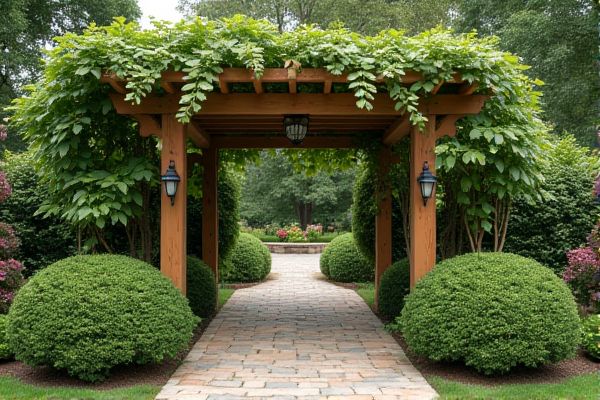
A trellis is typically a flat or angled framework used to support climbing plants like vines, offering a practical solution for vertical gardening, while an arbor is a freestanding, often decorative structure that creates a shaded walkway or seating area in your garden. Discover the key differences and benefits of each to choose the best option for your outdoor space by reading the rest of the article.
Table of Comparison
| Feature | Trellis | Arbor |
|---|---|---|
| Purpose | Supports climbing plants vertically | Provides shaded seating area, often decorative |
| Structure | Flat or angled lattice framework | Archway or gazebo-like framework |
| Material | Wood, metal, plastic lattices | Wood, metal, vinyl with benches |
| Installation | Mounted on walls or free-standing | Freestanding in gardens or pathways |
| Functionality | Plant support and decoration | Decoration and relaxation spot |
| Size | Typically smaller and thinner | Generally larger and more robust |
Understanding the Basics: What is a Trellis?
A trellis is a framework of open latticework made from wood, metal, or plastic designed to support climbing plants and vines, enhancing vertical gardening and maximizing garden space. Unlike an arbor, which often includes a covered passageway or archway for decorative and entry purposes, a trellis primarily provides structural support for plants to grow upward. Trellises improve air circulation and exposure to sunlight, promoting healthier plant growth and easier maintenance.
Defining an Arbor: Key Features and Functions
An arbor is a garden structure typically made from wood or metal, designed to support climbing plants like vines and roses while providing a shaded seating area. Its key features include a sturdy frame with open sides or lattice panels that facilitate plant growth and create a decorative focal point in outdoor spaces. Arbors function as both practical trellises for plant support and inviting outdoor retreats that enhance garden aesthetics and usability.
Trellis vs Arbor: Core Structural Differences
A trellis is a lightweight, lattice-like framework typically made from wood or metal, designed primarily for supporting climbing plants and creating vertical garden space. An arbor is more robust and often includes a roof or archway, serving as an architectural feature for garden entryways or seating areas while also supporting vines and plants. Your choice between a trellis and an arbor depends on whether you need a simple plant support structure or a decorative, functional garden element with a stronger framework.
Aesthetic Appeal: Design Styles and Visual Impact
Trellises often feature geometric patterns with clean lines, providing a modern aesthetic that enhances contemporary garden designs, while arbors typically offer curved, ornate structures that create a classic and romantic visual impact. Your choice between a trellis and an arbor depends on the desired style: trellises complement minimalist and formal spaces, whereas arbors serve as focal points or entranceways, adding depth and charm. Both structures support climbing plants, but their distinct design styles dramatically influence the overall ambiance and aesthetic appeal of your outdoor area.
Practical Uses: Garden Support and Plant Training
Trellises provide vertical support for climbing plants such as tomatoes, cucumbers, and beans, allowing for space-efficient gardening and improved air circulation. Arbors serve as structural garden features that support heavier vines like wisteria or grapevines while also creating shaded walkways or entryways. Both trellises and arbors facilitate effective plant training but differ in scale and architectural function within garden design.
Material Choices: Wood, Metal, and More
Trellises and arbors are crafted from various materials such as treated wood, wrought iron, aluminum, and vinyl, each offering different levels of durability and maintenance. Wood provides a natural, classic look with flexibility in design but requires regular treatment to prevent rot and insect damage. Metal options, including powder-coated aluminum and wrought iron, offer increased longevity and resistance to weather, making them ideal for long-term outdoor use.
Installation and Maintenance Requirements
Trellises typically require minimal installation, often mounted directly against a wall or fence, making them easier and quicker to set up compared to arbors, which usually need anchoring into the ground and more precise construction. Maintenance for trellises generally involves occasional cleaning and checking for structural integrity, whereas arbors may need more frequent upkeep due to their freestanding structure being exposed to weather elements on all sides. Both structures benefit from periodic treatments with weather-resistant finishes to prolong lifespan and prevent wood rot or rust, especially in outdoor garden environments.
Best Plant Pairings for Trellises and Arbors
Trellises are ideal for supporting climbing vegetables like cucumbers, beans, and peas, enabling vertical growth that maximizes garden space. Arbors create a charming focal point and work well with flowering vines such as wisteria, clematis, and roses, adding color and fragrance to pathways or entryways. Choosing the right structure enhances your garden's aesthetics and health by matching plant growth habits to sturdy, practical support.
Cost Comparison: Budget Considerations
Trellises generally offer a more budget-friendly option compared to arbors due to their simpler design and smaller size, often made from wood, metal, or vinyl with prices ranging from $30 to $150. Arbors, being larger and more elaborate structures, typically cost between $150 and $500 or more, depending on materials like cedar, redwood, or wrought iron and added features such as benches or decorative elements. For homeowners with tight budgets, trellises provide economical vertical gardening solutions while arbors serve as investment pieces enhancing garden aesthetics and property value.
Choosing the Right Structure for Your Garden
Trellises are vertical frameworks ideal for supporting climbing plants and creating space-saving garden designs, while arbors typically serve as decorative entryways or shaded seating areas with side panels for vines. Your choice depends on whether you prioritize functional plant support or enhancing garden aesthetics and ambiance. Selecting the right structure enhances plant growth and complements your garden's overall design.
 homyna.com
homyna.com